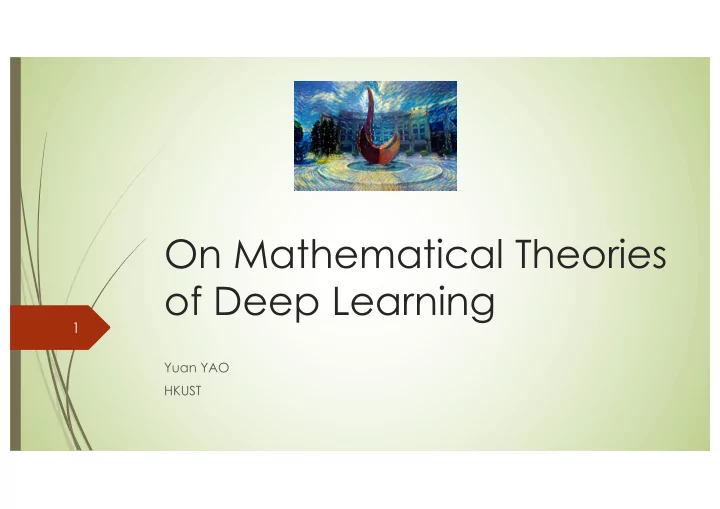

On Mathematical Theories of Deep Learning 1 Yuan YAO HKUST
Acknowledgement A following-up course at HKUST: https://deeplearning-math.github.io/
Outline ´ Why mathematical theories of Deep Learning? ´ The tsunami of deep learning in recent years… ´ What Theories Do We Have or Need? ´ Harmonic Analysis: what are optimal representation of functions? ´ Approximation Theory: when deep networks are better than shallow ones? ´ Optimization: what are the landscapes of risk and how to efficiently find a good optimum? ´ Statistics: how deep net models can generalize well?
Reaching Human Performance Level 1997 2004 AlphaGo “LEE” 2016 Deep Blue in 1997 AlphaGo ”ZERO” ¡D ¡Silver ¡ et ¡al. ¡Nature 550, ¡ 354–359 ¡(2017) ¡doi:10.1038/nature24270
ImageNet Dataset 14,197,122 labeled images 21,841 classes Labeling required more than a year of human effort via Amazon Mechanical Turk
ImageNet Top 5 classification error ImageNet (subset): 1.2 million training images 100,000 test images 1000 classes ImageNet large-scale visual recognition Challenge source: https://www.linkedin.com/pulse/must-read-path-breaking-papers-image-classification-muktabh-mayank 13 /
Crowdcomputing: researchers raising the competition record
Depth as function of year [He et al., 2016]
Growth of Deep Learning
New Moore’s Laws CS231n attendance NIPS registrations
"We’re at the beginning of a new day… This is the beginning of the AI revolution.” — Jensen Huang, GTC Taiwan 2017
Some Cold Water: Tesla Autopilot Misclassifies Truck as Billboard Problem: Why? How can you trust a blackbox?
Deep Learning may be fragile in generalization against noise! [Goodfellow et al., 2014] Small but malicious perturbations can result in severe misclassification Malicious examples generalize across different architectures What is source of instability? Can we robustify network?
Kaggle survey: Top Data Science Methods https://www.kaggle.com/surveys/2017 Academic Industry
What type of data is used at work? https://www.kaggle.com/surveys/2017 Academic Industry
What’s wrong with deep learning? Ali Rahimi NIPS’17: Machine (deep) Learning has become alchemy . https://www.youtube.com/watch?v=ORHFOnaEzPc Yann LeCun CVPR’15, invited talk: What’s wrong with deep learning? One important piece: missing some theory ! http://techtalks.tv/talks/whats-wrong-with-deep-learning/61639/
Perceptron: single-layer Invented by Frank Rosenblatt (1957) b x 1 w 1 x 2 w 2 · f ( z ) z = − → w · − → x + b · · w d x d
Locality or Sparsity of Computation Minsky and Papert, 1969 Perceptron can’t do XOR classification Perceptron needs infinite global locality of computation? information to compute connectivity Locality or Sparsity is important: Locality in time? Locality in space?
Multilayer Perceptrons (MLP) and Back-Propagation (BP) Algorithms Rumelhart, Hinton, Williams (1986) Learning representations by back-propagating errors, Nature, 323(9): 533-536 BP algorithms as stochastic gradient descent algorithms ( Robbins–Monro 1950; Kiefer- Wolfowitz 1951 ) with Chain rules of Gradient maps MLP classifies XOR, but the global hurdle on topology (connectivity) computation still exists
Recommend
More recommend